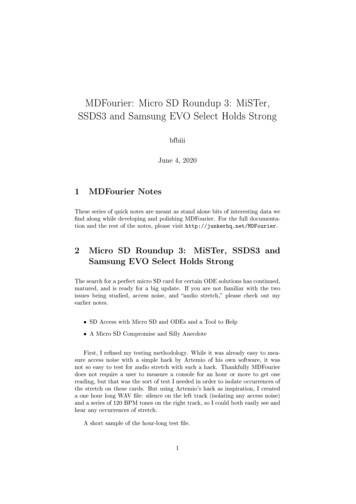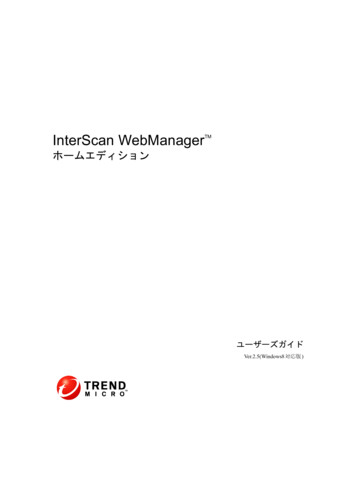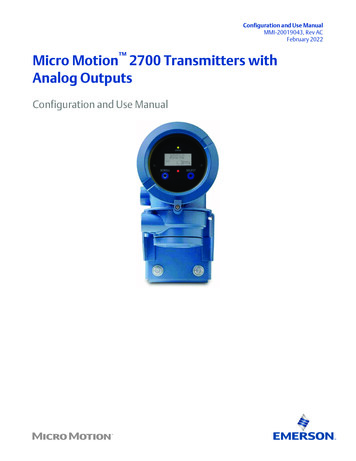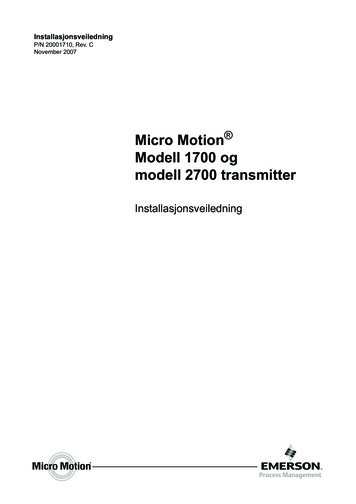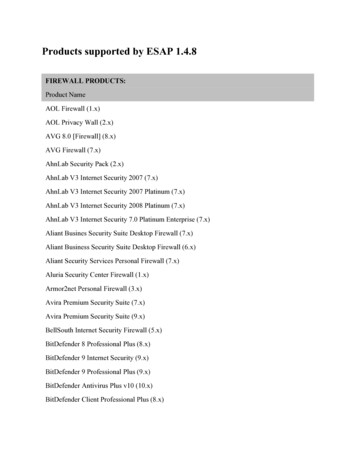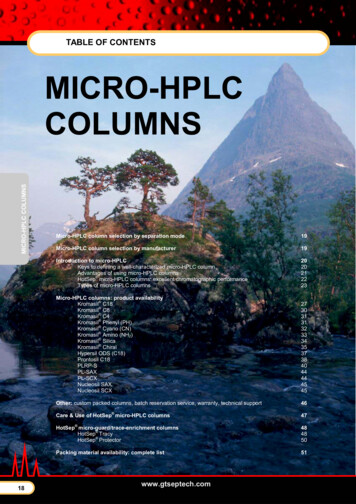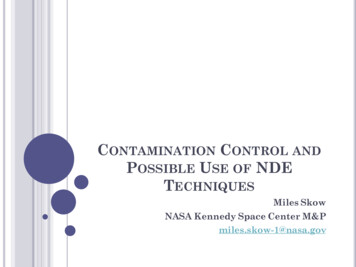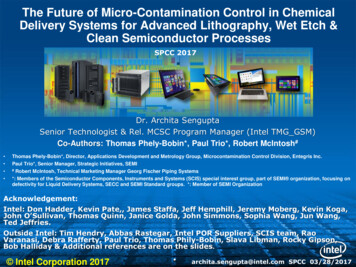
Transcription
The Future of Micro-Contamination Control in ChemicalDelivery Systems for Advanced Lithography, Wet Etch &Clean Semiconductor ProcessesSPCC 2017Dr. Archita SenguptaSenior Technologist & Rel. MCSC Program Manager (Intel TMG GSM)Co-Authors: Thomas Phely-Bobin*, Paul Trio*, Robert McIntosh# Thomas Phely-Bobin*, Director, Applications Development and Metrology Group, Microcontamination Control Division, Entegris Inc. Paul Trio*, Senior Manager, Strategic Initiatives, SEMI # *: Members of the Semiconductor Components, Instruments and Systems (SCIS) special interest group, part of SEMI organization, focusing ondefectivity for Liquid Delivery Systems, SECC and SEMI Standard groups. *: Member of SEMI OrganizationRobert McIntosh, Technical Marketing Manager Georg Fischer Piping SystemsAcknowledgement:Intel: Don Hadder, Kevin Pate,, James Staffa, Jeff Hemphill, Jeremy Moberg, Kevin Koga,John O’Sullivan, Thomas Quinn, Janice Golda, John Simmons, Sophia Wang, Jun Wang,Ted Jeffries.Outside Intel: Tim Hendry, Abbas Rastegar, Intel POR Suppliers, SCIS team, RaoVaranasi, Debra Rafferty, Paul Trio, Thomas Phily-Bobin, Slava Libman, Rocky Gipson,Bob Halliday & Additional references are on the slides. Intel Corporation 2017 archita.sengupta@intel.com SPCC 03/28/2017
Overview Beyond 14nm: New Challenges with Supply line contamination and Nano-defectivity IDM Perspective of Problem Statement and End Goal Examples of Wafer Contamination Sources and Importance Addressing the Gaps: Criticality of Metrology Requirement: Defect Identification/Characterization Supply Chain Responsibility & Quality Control Need for Industry Collaboration: Joint Responsibility Expectation from POR Suppliers End remarks Intel Corporation 2017archita.sengupta@intel.com SPCC 03/28/2017
Innovation Enabled Technology PipelinePrecision Structure control32 nm22 nm14 nm10 nmManufacturing7 nm 5 Grapheneenhancementincreasing design Nontraditional Scaling, more3D type processarchitectural changesinnovation,sensitivity& complexity increasing design innovation,integrationtricks & emoryInterconnectPhotoniNanow/increased process steps, process sensitivity & complexityscswires Shrinking feature size translates into: More possible newerdefects and less defect tolerance Need To “Redefine” DefectsFuture options subject to changeGenerationalIncreasein New MaterialsThe Future New Equipment& MaterialsHigher Density& IntegrationLower Cost PerTransistor Lithography Scaling and Cost of Ownership EnableMoore’sLaw Defectivityimprovement is major key for HVM Shrinking feature size is adding more possibleyield enhancement and keeping cost/transistordefects/challenges and less defect tolerancedown Defectivity improvement is major key for HMV yieldimprovement and keeping cost/transistor down100s of different materials ofunprecedented purity and processmaturity need Intel Corporation 20173 el.comSPCCGSM 03/28/201709/21/2016
Challenges in Defectivity Control beyond 14nm Paradigm shift in thoughts about what we didn’t care before, but we have to care tocontrol now! What was “Process Variation” for previous Technology Nodes, can now be “Excursion”! Integration of “Many” new, enabling materials creates challenges in purity and processmaturity Complex Chemistry: Compatibility Issues New Defect Sources, increase Defect Sensitivity Metrology techniques of all types are challenged to provide sufficient sensitivity for earlydetection & prevention Supplier Infrastructure Development is lacking for better defect detection &characterization Metrology and Quality Control Need characterization and control established by a SEMI standard so that IDM productioncan be protected by all sectors of the supply chain regardless of the source Intel Corporation 2017archita.sengupta@intel.com SPCC 03/28/2017
HVM Requirements Consistency/Predictability of and Less Start Up Time: Less Flushing for initial particles and metal ions extraction Always Up and Running tools/Chemical Delivery Systems Need a very tight distribution of performance to bring up new tools Less Process Down Time: Productivity Improvement Reduce excursion of particles/metal ions Environmental Control (No adders from components) Meet “On wafer” Defectivity Baseline (Process/Materials/Equipment) Smaller particles Metal ions Organics/NVR Consistency and Quality Control of “All” the products for HVM use Across Supply Chain Intel Corporation 2017archita.eengupta@intel.com SPCC 03/28/2017
Global Control Needed for DefectivitySupply LineManufacturing: UPW,Chemicals, Gases,FiltrationDefectMonitorand IDAreAdvanced NodeParticle/ContaminationMonitoring techniquesavailable?Reliable?Slide idea ref: A. s Defect on wafer correlatewith defect in processchemicals and MonitorTool Suppliers/OEMParts, Valves, Fluiddelivery System (BCD,PCD, ita.eengupta@intel.com Intel Corporation 2017SPCC 03/28/2017
Contamination Interface ModelMany of the criticalcomponent systems do nothave Spec, or RequiredMeasurement standards. Many of the NewChemistries do not havespec. Interaction of Chemistryand Tools: Lowconcentration ofparticles/metals/NVR/Organics defects These Defects “Need to beDetected,Eliminated/Mitigatedacross supply chain”Environment –(Molecules ofUPW, Air, Gas,Chemicals)ContaminationContaminationCritical Substrate (i.e., Wafer, Mask, Lens) Critical Components (I.e., Nozzles, Valves)Started w/ SCIS charter, WECC -- still quite a bit of way to go! CollaborationTotal Wafer EnvironmentalContaminationSecondaryCritical Characterization & Control are Essential forYield EnhancementSystems/Environments(i.e., PCW)Slide cartoon Ref: Slava LibmanOther information Intel Corporation 2017archita.sengupta@intel.com SPCC 03/28/2017
Which Wafer Defects Impact Yield? Environmental and Process Contamination related Particles MetalsAre we Monitoring these sourcesacross supply line? Organics NVR Defects in starting materials Printable defects during lithography process Process-induced patterning and device defects Intel Corporation 2017archita.sengupta@intel.com SPCC 03/28/2017
Intel Corporation 2017Example of Metrology Challenges: ChemsMaterialMajor ChallengeGap in Metrology for ControlGap in Metrology forCharacterizationWet chemsandformulatedchems,Solvents,Litho chem Residues (TraceMetals/organics/Particles) Interaction w/criticalcomponents Main component assay is insufficient for customblend chem Filtration may not be sufficient? LPC: HVM monitor needs 30nm bin size. Specific detectors to enhancedetectability High resolution to help ID theunknown ICPMS DL, MS techniques toprovide better ID capability.CMP MPS trending 100nm, Complex interactionsbetweenchemicals/consumables:Filter Nano-particleinteraction Performance-based monitors may be required Normal impurity profile variation of commonlyused Industrial-grade additives no longeracceptable Improved analytical metrologyto characterize abrasive colloids( 20nm sized particle, a minutemass fraction of the heterodispersed abrasive PSD) Traditional CofA parametersnot sufficient to predictperformance Intel Corporation 2017archita.sengupta@intel.com SPCC 03/28/2017
Defects caused by Chemical Handling andDelivery System (Chemical Pass) As chemical travels within any dispense system, contamination isadded (leaching and/or reaction with components) PFA Tubing May lead to “Metal Leaching”Changing the Industry: New SEMI C90-1015 standardhas been published: for limiting the amount of Fe in PFAmaterials (tube, valves, fittings, resin) used in thesemiconductor industry for liquid chemicaldistribution.(Oct 2015)ChemicalEntering(Postfiltration) Intel Corporation 2017Over time: Metal Leaching Deposition ofparticles/organics (fromhydrodynamic boundary layer) Dislodgement of particlesChemical Exit (PM,Dispense rate, idletime etc.determine theresidence time)archita.sengupta@intel.com SPCC 03/28/2017
Filtration Technology Must Keep Up with Defect Scaling Customized Filtration is needed to meet “Paradigm Shift in Defect Tolerance” How to remove of 5nm Metals/Particles/Organics/NVR from Chemicals? Intel Corporation 201703/28/2017
Analytical Metrology and Defect Analysis GapReality Intel Corporation 2017Wish Wellarchita.sengupta@intel.com SPCC 03/28/2017
SMC Defect Analysis and CharacterizationGapsNeed Hybrid Analysis Technology for Defect IDAnalyticalMethodsLimitationsPhysical StructureSEM, e-SEM,TEM, AFM, XRDChemical/ElementalComposition (solidsand Surfaces)Chemical/elemental(Solids, Liquids,Gases) Raman/SERS(Semi-Qualitative) FTIR (Qualitative) Auger, EDS(Elemental) SIMS, TOF SIMS,XPS (Quantitative,Chemical ID) EELS, TXRF, XRF FCS (Novel)GCMS, TD GCMS,ICPMS, VPD-ICPMS,IC, LCMS Autofiltration, CRDS, FTIR,FCSGaps & Supply line concern Quantified Nano-mechanical measurement is becoming more andmore critical for 10nm defects. tip/ defect artifacts for sub 10 nmdefects? EDS on TEM samples for sub 10 nm defects. – Challenging Limitations below 500nm, Near field AFM Raman? Limitations 10um-5um AFM-FTIRGreat surface resolution Difficult at 100nm-200nm Low Z elements difficultCMP particle characterization @ 20nm size, more sensitivity than DLS Need better sensitivity and DLWhat Standardized Metrology andAnalytical tools can be used 10nmDefect Identification!Can I see it?Do I know what it is? Intel Corporation 2017archita.sengupta@intel.com SPCC 03/28/2017
Particle Metrology Gap: On Surface vs. In-Situ Liquid Alternative for Advanced e-beam orSPx across Supply chain particledetection?108Particle conc (#/ml)107106105Particle Dynamics in Low particlesconc of 20nm particles detection?!Aerosol Metrology (DMA CPC)?DLS?“Blind” toSPM?killerdefects inincomingchemicals?LPCLPC* LPC*20nm 30nm 40nmDI Chem DI/Chem104?10310210 Reliable LPC for 20 nm particledetection (Chem/DIW/Solvent)? Detection efficiency/Sensitivity at lowconc. Blended chemistry challenges (Microbubbles, micelles) Correlation between LPC counts andon-wafer defects for advanced nodes Increased Sensitivity to Impurities isnot identified on ITRS Roadmap due toMeasurement Limits: Need forULTRAPUREChemicalsNeed to be hereUPW02510203050100Particle size (nm) Current liquid-based analytical LDLsare not comparable to gas-basedinstrumentation200300500 Intel Corporation 2017Slide Information Reference sources: Abbas Rastegar/SEMATCH and Various Suppliers, J. Hemphill/Intelarchita.sengupta@intelSPCC 03/28/2017.com
How do we Control/Prevent the Contaminants? 1st Request: Three major control of the contaminants before ship the“Best” products to the factory: The Materials The Equipment The ComponentsCritical component 2nd Request: We Cannot Evaluate Advanced Node Chemistry/ProcessWithout Aggressive “Super-Filtration And Purification” Need ultrapure materials, extreme retention, lowest possible interaction Optimized at chemical manufacturing and at factory processing/tools 3rd Request: Help us closing the Metrology/Analysis/Standard Gaps 4th Request: Work Together: Collaboration Intel Corporation 2017Picture Ref: Hera & Athena handshaking, late 5th century BC, Acropolis Museum,Athensarchita.sengupta@intel.comSPCC 03/28/2017
Semiconductor Ecosystem Must Work Together Increasing interdependency with process complexity: Materials and Equipment Specs : Process Control And Traceability Need to re-write “Advanced Semi-Standards” for MeasurementDeviceMaterialsCollaboration forDefect Control to meetthe target for TechnologyPerformance Process Yield Device CostEquipment Process is as good asControl & Baseline What Matrix are wemeasuring? What Methodology weare applying? Need Complete Supply Line Visibility and High Level of Trust Develop Joint Analytical capabilities for Defect Detection and ID Success requires collaboration across all supply chain partnersIndustry Must Collaborate on ONE PLATFORM to redefine Materials &Equipment “Specs & Metrology Standards” for 14nm Node Intel Corporation 2017archita.sengupta@intel.com SPCC 03/28/2017
Collaborate on One Industry Platform andhelp each other? 1yearSlide idea ref: Slava Libman Intel Corporation 2017 archita.sengupta@intel.comSPCC 03/28/2017
Major Challenges: work within IP boundaries Acquire adequate fundingSPCC 03/28/2017
SEMI Component, Instrument and Subsystem(SCIS) Special Interest GroupSCIS: Critical Component-OEM End User Team Goal: To Create Standard System ofcomparable Metrics which will be used torate, compare and classify processcritical OEM components in order toreduce defects generated inSemiconductor manufacturingComponents such as seals, filters, massflow controllers, valves, sensors, ion beamsources, etc. Instruments for in-line and off-line datameasurement, collection, and monitoring Sub-systems that support process tools e.g.vacuum, robotics, power conversion,abatement, chillers, etc. Establish a general “framework” to guideIndustry partners to Define observable/measurable defects Define comparable category attributesspecific to each category component Define methods for identifying defectsrelated to each category Guide industry to utilize the frameworkSlide Ref: Paul Trio, D. Rafferty, D. Vernikovsky Intel Corporation 2017archita.sengupta@intel.comSPCC 03/28/2017
SCIS – SEMI – Other Industry Platforms AlignmentFrom Technology Gaps to SEMI Standards Other Industry PlatformsSEMI SCIS Roles– Provide supply chaininputs on criticalcomponents andrelated parameters thatneed measurementmethods established– Define framework forcomponentcharacterization– Implement developedSEMI Standardsthroughout supplychain, identify gaps andnew requirements– Develop test methods formeasuring materials defectcontribution as well asmeasuring performance ofrelated componentsSEMISCISProvide regular updates,reporting on progress andgaps to maintain alignmentSEMIStandards– Obtain SCIS inputs onmeasurement methods indevelopmentOther – Conducttesting/experiments toIndustryplatforms validate measurementmethods SEMI Standards Roles– Establish appropriate task force, develop/publishstandardsSPCC 03/28/2017
SCIS – SEMI TASK Force (TF) Definition of “Surface Contamination & High Surface Area components” – high puritypolymers, high flow components Dynamic Rinse vs. Static Rinse contribution Definition of “Particles” (& Size to meet 7nm Node requirement!) And Beyond Particles(TOC, NVR) F63: Gap in definition due to lack of metrology @ killer defects!SPCC 03/28/2017
SPCC 03/28/2017
Success Story of Collaboration to ChangeSEMI Standard: SEMI C90-1015 Changing the Industry – One Step at a time. Led by Intel - New industry standard for measuring/limiting the amount ofIron contamination in PFA materials (tube, valves, fittings, resin) used in thesemiconductor industry for liquid chemical distribution has been published bythe SEMI organization (2015) Next, defining the frequency of the test and the reporting medium for theresults so as to monitor and manage the supply chain Many suppliers were involved with this new standard development and haveadopted transition Intel Corporation 2017archita.sengupta@intel.com SPCC 03/28/2017
End Reflection Leadership means Corporate Responsibility 14nm and Beyond: We have paradigm shift in processscaling/defectivity challenges: Process Variation can end up asExcursion Interdisciplinary expertise need to work together– Tool suppliers, Material suppliers, Filter Suppliers, Componentsuppliers, Metrology suppliers and IDMs need to work together toachieve required defectivity baseline and create new STANDARDS Next Generation Quality Systems combined with Sub-SupplierManagement helps to achieve “Ship to Control Across Supply Chain”,makes IDM “Quality Incident Free” and minimize costly learning duringHVM ramp Intel Corporation 2017archita.sengupta@intel.comSPCC 03/28/2017
Thank YOU To My Co-Authors All My Intel colleagues for contributing to the content of the presentation To Abbas Rastegar as referenced and always providing valuable input To All Intel Suppliers: Thank You for Your Valued Partnership To SPCC Committee for the opportunity to presentArchita Intel Corporation 2017archita.sengupta@intel.com SPCC 03/28/2017
Risk Factors The above statements and any others in this document that refer to plans and expectations for the first quarter, the year and the future are forwardlooking statements that involve a number of risks and uncertainties. Words such as “anticipates,” “expects,” “intends,” “plans,” “believes,” “seeks,”“estimates,” “may,” “will,” “should” and their variations identify forward-looking statements. Statements that refer to or are based on projections,uncertain events or assumptions also identify forward-looking statements. Many factors could affect Intel’s actual results, and variances from Intel’scurrent expectations regarding such factors could cause actual results to differ materially from those expressed in these forward-lookingstatements. Intel presently considers the following to be the important factors that could cause actual results to differ materially from the company’sexpectations. Demand could be different from Intel's expectations due to factors including changes in business and economic conditions, includingsupply constraints and other disruptions affecting customers; customer acceptance of Intel’s and competitors’ products; changes in customer orderpatterns including order cancellations; and changes in the level of inventory at customers. Uncertainty in global economic and financial conditionsposes a risk that consumers and businesses may defer purchases in response to negative financial events, which could negatively affect productdemand and other related matters. Intel operates in intensely competitive industries that are characterized by a high percentage of costs that arefixed or difficult to reduce in the short term and product demand that is highly variable and difficult to forecast. Revenue and the gross marginpercentage are affected by the timing of Intel product introductions and the demand for and market acceptance of Intel's products; actions taken byIntel's competitors, including product offerings and introductions, marketing programs and pricing pressures and Intel’s response to such actions;and Intel’s ability to respond quickly to technological developments and to incorporate new features into its products. Intel is in the process oftransitioning to its next generation of products on 22nm process technology, and there could be execution and timing issues associated with thesechanges, including products defects and errata and lower than anticipated manufacturing yields. The gross margin percentage could varysignificantly from expectations based on capacity utilization; variations in inventory valuation, including variations related to the timing of qualifyingproducts for sale; changes in revenue levels; product mix and pricing; the timing and execution of the manufacturing ramp and associated costs;start-up costs; excess or obsolete inventory; changes in unit costs; defects or disruptions in the supply of materials or resources; productmanufacturing quality/yields; and impairments of long-lived assets, including manufacturing, assembly/test and intangible assets. The majority ofIntel’s non-marketable equity investment portfolio balance is concentrated in companies in the flash memory market segment, and declines in thismarket segment or changes in management’s plans with respect to Intel’s investments in this market segment could result in significantimpairment charges, impacting restructuring charges as well as gains/losses on equity investments and interest and other. Intel's results could beaffected by adverse economic, social, political and physical/infrastructure conditions in countries where Intel, its customers or its suppliers operate,including military conflict and other security risks, natural disasters, infrastructure disruptions, health concerns and fluctuations in currencyexchange rates. Expenses, particularly certain marketing and compensation expenses, as well as restructuring and asset impairment charges,vary depending on the level of demand for Intel's products and the level of revenue and profits. Intel’s results could be affected by the timing ofclosing of acquisitions and divestitures. Intel's results could be affected by adverse effects associated with product defects and errata (deviationsfrom published specifications), and by litigation or regulatory matters involving intellectual property, stockholder, consumer, antitrust and otherissues, such as the litigation and regulatory matters described in Intel's SEC reports. An unfavorable ruling could include monetary damages or aninjunction prohibiting us from manufacturing or selling one or more products, precluding particular business practices, impacting Intel’s ability todesign its products, or requiring other remedies such as compulsory licensing of intellectual property. A detailed discussion of these and otherfactors that could affect Intel’s results is included in Intel’s SEC filings, including the annual report on Form 10-K for the fiscal year endedDecember 31, 2011.Rev. 2/23/12
Defects caused by Chemical Handling and Delivery System (Chemical Pass) As chemical travels within any dispense system, contamination is added (leaching and/or reaction with components) PFA Tubing May lead to "Metal Leaching" Chemical Entering (Post filtration) Chemical Exit (PM, Dispense rate, idle time etc. determine the residence time)





